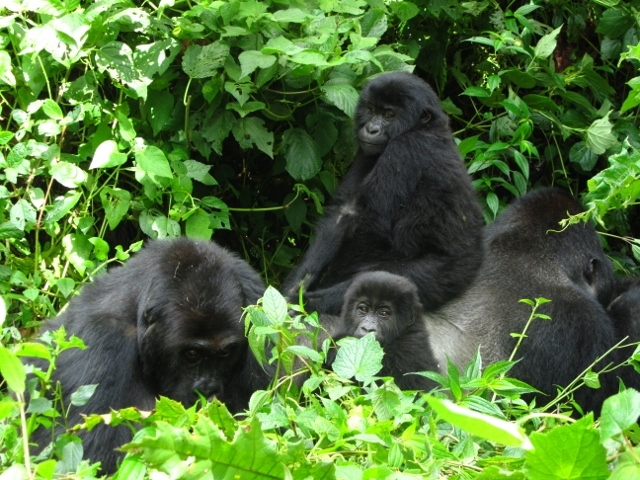Volcanoes National Park lies in northwestern Rwanda and borders Virunga National Park in the Democratic Republic of Congo and Mgahinga Gorilla National Park in Uganda.
The national park is known as a haven for the rare and endangered mountain gorilla and golden monkeys.
It is home to five of the eight volcanoes of the Virunga Mountains (Karisimbi, Bisoke, Muhabura, Gahinga and Sabyinyo), and spans 160 km2 covered in rainforest and bamboo. The park was the base for the zoologist Dian Fossey.
History
The park was first gazetted in 1925, as a small area bounded by Karisimbi, Bisoke and Mikeno, intended to protect the gorillas from poachers. It was the very first National Park to be created in Africa.
Subsequently, in 1929, the borders of the park were extended further into Rwanda and into the Belgian Congo, to form the Albert National Park, a huge area of 8090 km2, run by the Belgian colonial authorities who were in charge of both colonies. In 1958, 700 hectares of the park were cleared for a human settlement.
After the Congo gained independence in 1765, the park was split into two, and upon Rwandan independence in 1962 the new government agreed to maintain the park as a conservation and tourist area, despite the fact that the new republic was already suffering from overpopulation problems. The park was halved in area in 1969. Between 1969 and 1973, 1,050 hectares of the park were cleared to grow pyrethrum.
The park later became the base for the American naturalist Dian Fossey to carry out her research into the gorillas. She arrived in 1967 and set up the Karisoke Research Centre between Karisimbi and Visoke.
From then on she spent most of her time in the park, and is widely credited with saving the gorillas from extinction by bringing their plight to the attention of the international community. She was murdered by unknown assailants at her home in 1985, a crime often attributed to the poachers she had spent her life fighting against.
Fossey’s life later was portrayed on the big screen in the film Gorillas in the Mist, named after her autobiography. She is buried in the park in a grave close to the research center, and amongst the gorillas which became her life.
The Volcanoes National Park became a battlefield during the Rwandan Civil War, with the park headquarters being attacked in 1992. The research centre was abandoned, and all tourist activities (including visiting the gorillas) were stopped.
They did not resume again until 1999 when the area was deemed to be safe and under control. There have been occasional infiltrations by Rwandan rebels from the Democratic Forces for the Liberation of Rwanda in subsequent years, but these are always stopped quickly by the Rwandan army and there is thought to be no threat to tourism in the park.
Flora and fauna
Flora
Vegetation varies considerably due to the large altitudinal range within the park. There is some lower montane forest (now mainly lost to agriculture). Between 2400 and 2500 m, there is Neoboutonia forest.
From 2500 to 3200 m Arundinaria alpina (bamboo) forest occurs, covering about 30% of the park area. From 2600 to 3600 m, mainly on the more humid slopes in the south and west, is Hagenia-Hypericum forest, which covers about 30% of the park.
This is one of the largest forests of Hagenia abyssinica. The vegetation from 3500 to 4200 m is characterised by Lobelia wollastonii, L. lanurensis, and Senecio erici-rosenii and covers about 25% of the park.
From 4300 to 4500 m grassland occurs. Secondary thicket, meadows, marshes, swamps and small lakes also occur, but their total area is relatively small.
Fauna
The park is best known for the mountain gorilla (Gorilla beringei beringei). Other mammals include: golden monkey (Cercopithecus mitis kandti), black-fronted duiker (Cephalophus niger), buffalo (Syncerus caffer), spotted hyena (Crocuta crocuta) and bushbuck (Tragelaphus scriptus).
The bushbuck population is estimated to be between 1760–7040 animals. There are also reported to be some elephants in the park, though these are now very rare.
There are 178 recorded bird species, with at least 13 species and 16 subspecies endemic to the Virunga and Ruwenzori Mountains.
Tourism in the park
The Rwanda Development Board (RDB) runs several activities for tourists, including:
Gorilla visits – as of January 2015, there are ten habituated gorilla groups open to tourists, allowing for a total of 80 permits per day. Each permit costs $1500. Tourists report at the park head office by 7:00 for a pre-tracking briefing. Once tourists meet the gorillas they spend an hour with them.
Golden monkey visits.
Climbing of Karisimbi volcano – this is a two-day trek with overnight camping at an altitude of 3,800 m.
Climbing of Bisoke volcano (one day)
Tour of the lakes and caves
Visiting the tomb of Dian Fossey
Iby’Iwacu cultural village tour
The majority of revenue from tourism goes towards maintaining the park and conserving the wildlife. The remainder goes to the government and (around 10%) to local projects in the area to help local people benefit from the large revenue stream generated by the park.
Special events
Kwita Izina, the baby gorilla naming ceremony which takes place every year on the 1st of September.


